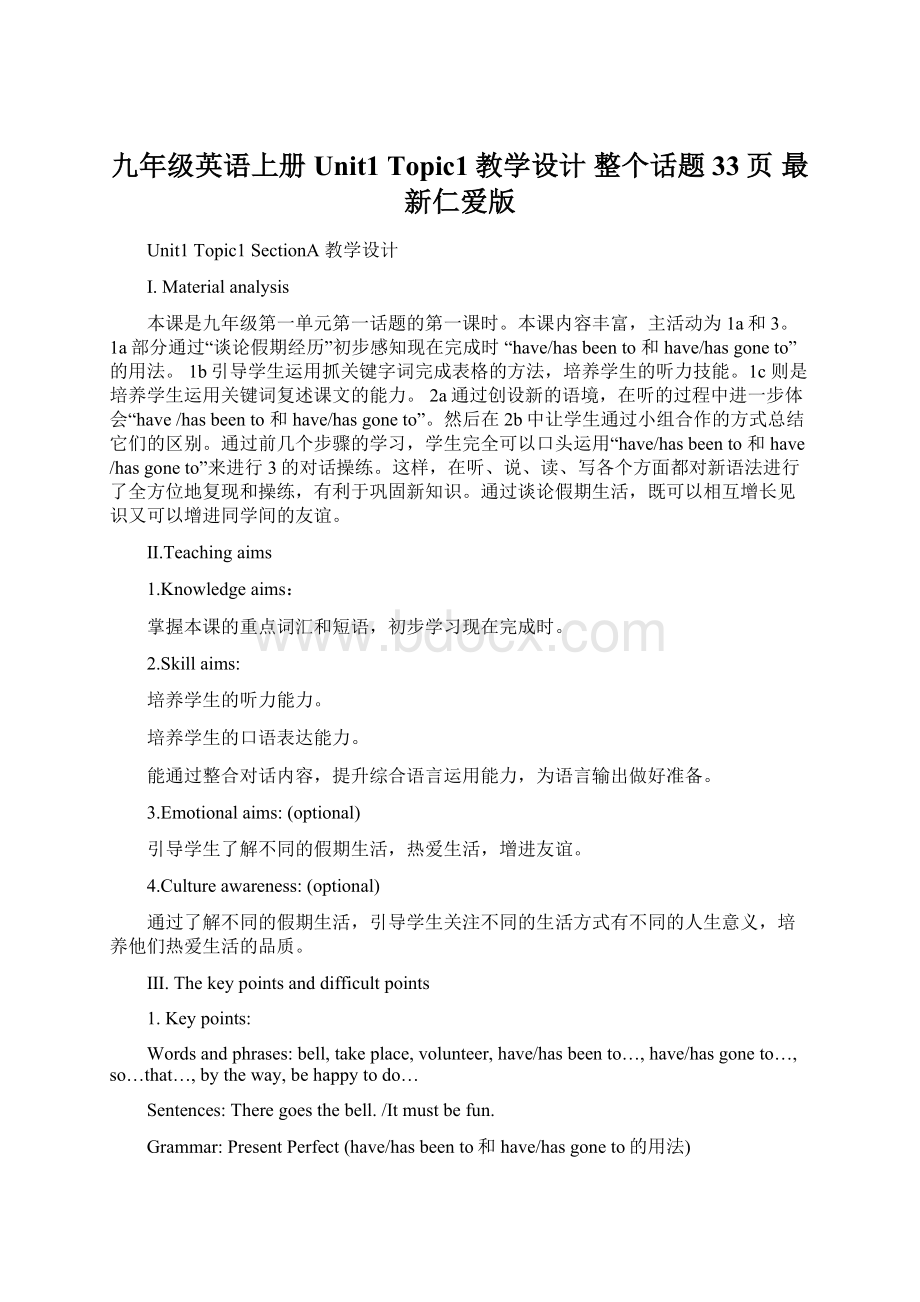九年级英语上册Unit1 Topic1教学设计 整个话题33页 最新仁爱版Word格式.docx
《九年级英语上册Unit1 Topic1教学设计 整个话题33页 最新仁爱版Word格式.docx》由会员分享,可在线阅读,更多相关《九年级英语上册Unit1 Topic1教学设计 整个话题33页 最新仁爱版Word格式.docx(39页珍藏版)》请在冰豆网上搜索。

4.Cultureawareness:
通过了解不同的假期生活,引导学生关注不同的生活方式有不同的人生意义,培养他们热爱生活的品质。
Ⅲ.Thekeypointsanddifficultpoints
1.Keypoints:
Wordsandphrases:
bell,takeplace,volunteer,have/hasbeento…,have/hasgoneto…,so…that…,bytheway,behappytodo…
Sentences:
Theregoesthebell./Itmustbefun.
Grammar:
PresentPerfect(have/hasbeento和have/hasgoneto的用法)
2.Difficultpoints:
能通过听、说和读的方式感知并掌握have/hasdone的用法。
能区别并会恰当使用have/hasbeento和have/hasgoneto。
Ⅳ.Learningstrategies
培养学生通过图表信息重组语言的综合能力。
教会学生如何在听的过程中提取关键词。
培养学生通过图片表达相应信息的能力。
Ⅴ.Teachingaids
单词卡片或者幻灯片;
家乡或所去城市的风景照片等。
Ⅵ.Teachingprocedures
Stage
(timeperiod)
Interaction
patterns
Teacheractivity
Studentactivity
Remarks
1
Gettingstudentsreadyforlearning
(4-6mins)
Classactivity
Brainstorming:
Showsomepicturesofsomefamousplaces.GettheSstospeakouttheirnamesasquicklyaspossibletoarousetheSs’interest.
T:
Boysandgirls,thebellisringing.Let’sbeginourclass.
Herearelotsofpictures.Nowpleasespeakouttheirnamesasquicklyasyoucan.Areyouready?
Ss:
Yes!
Herewego!
Speakoutthenamesofthecountries.
Ss…
让学生更加熟悉各国名称,为1a学习做好准备。
建议一:
也可使用自己旅游时的照片或当地比较有特色的风景图片,让学生猜地名,提升学习兴趣。
建议二:
可使用freetalk的方式,用一般过去时自由谈论假期生活。
2
Pre-listening
(15mins)
Roundrobin
Pairwork
Groupwork
Step1:
PresentthelastpictureofWenchuan,gettheSstoguessthemeaningofthenewwordsandthenteachthenewwords.
Whathappenedtherein2008?
(地震)
Yes.Anearthquakehastakenplacethere.Manyvolunteerswenttheretohelpthem.
Step2:
Presentthenewsentencestructuresandthenaskandansweronebyoneineachgroup.
IhavebeentoWenchuan,too.
Wherehaveyoubeen?
Ihavebeento…
Now,let’saskandansweronebyoneineachgroup.
S1…S2...S3…S4…S5…S6…S1
Step3:
Presentthenewsentencestructuresandthenaskandanswerwithpartners.
WhereisS5?
Hewenttothewashroom?
Yes,hehasgonetothewashroom.Andwethinkhewillbebacksoon.WhereisMissZhu(ateacherofyourclass)?
Shehasgoneto…
Nowaskandanswerwithyourpartners.
…
Step4:
GettheSstodiscussthedifferencesbetweenhave/hasbeentoandhave/hasgoneto.Chooseonegrouptostatethepointsandotherscanaddtheirideas.Finish2b.
OK,nowpleaseshareyouranswerswithus.Otherslistencarefullyandcanaddyourideas.
Step5:
LettheSsmakeconversationsinpairsandactthemout.Finish3.
Nowlookattheexample,let’sreadittogether.
Pleasemakenewdialogsaccordingtothe
pictures?
Let’sinvitesomeofyoutoactoutyourdialog.
Guessthemeaningofthewordsaccordingtotheteacher’sdescriptions.
Askandansweronebyoneineachgroup.
Practicethedialoginpairs.
Discussthedifferencebetweenhave/hasbeentoandhave/hasgonetoandthenmakeapresentation.Finish2b.
Makeconversationsinpairsandfinish3.
让学生在具体的语言环境中感知新单词,有助于更快更好的记住它们。
给学生创设良好的语言环境,有助于学生更好的体会和掌握该句式。
在环境中感知语言,才能更好地用语言做事情。
教会学生及时归纳和总结所学知识是学好语言的策略之一。
建议:
教师应根据实际给予不同程度的肯定与奖励。
及时的巩固训练是内化语言的有效途径。
教师可以根据需要在第三部分适当增加有地方特色的图片,用来练习,可以更好的贴近实际生活。
教师可以用简笔画,在黑板上展示两个短语的不同之处,更加清晰明了。
建议三:
展示环节,建议让学生互动评价,指出优缺点,更好地使全体学生参与课堂。
3
While-listening
(8mins)
Individualwork
Step1:
GettheSstrytofillintheblanksin1bbeforelistening.Thenlistenandchecktheanswers.Finish1b.
First,trytofillintheblanksbeforelistening.Thenlistenandchecktheanswersbyyourselves.
T:
DoyouknowwhereKangkang,Jane,RitaandMariahavebeen?
Nowlet’slistenandcompletethechartin1b.
Listento1aandpayattentiontothepronunciationandintonationandthenread1a.
Step3:
Listentotheconversationin2aandfillintheblanks.Payattentiontothepresentperfecttense.
Fillintheblanksin1bbeforelistening.Thenlistenandchecktheanswers.Finish1b.
Listento1aandpayattentiontothepronunciationandintonationandthenread1a.
Finish2aand2b.
听力训练之前,试着填空,能更好地预测听力内容。
语言学习,读的过程很重要,教师可以根据班级情况,分配朗读的方式和时间。
4
After-listening
Readthe1aagainandguidetheSstounderlinethestructureslike“have/hasdone”.
Listentothe1aagainandpleaseunderlinethestructureslike“have/hasdone”andthekeypoints.
Step2:
LettheSsdiscussthekeypointsandsolvetheproblemsbythemselves.
Nowpleasedealwiththedifficultpointsbyyourselvesandyoucanaskyourgroupmembersforhelp.
Retell1aaccordingto1b,finish1c.
Trytoretell1aaccordingto1b.
Nowlet’sretell1a.
S1:
RitahasbeentomanyplacesnearherhomeinIndia.Herhometownhasbecomemoreandmorebeautiful.JanehasbeentoMountHuangwithherparents.It’sbeautiful,butthereweretoomanypeople…
Readtheconversationthoroughlyandunderlinethepointstheydonotunderstand.
Discussthekeypointsandsolvetheproblemsbythemselves.
Retell1aaccordingto1b.
该环节教师应提供参考资料和方法指导,以提升学生的自学能力和培养克服难关的意识。
小组内不能解决的问题,组间可以互相帮助解决。
学生水平有限的话,老师可以直接讲解知识点。
该环节教师可以根据实际情况,采用不同的互动模式,可以是班级活动,结对活动,也可以是个人活动。
5
Summarizingandasigninghomework(5mins)
Sumupthemaincontentofthisclassandrepeatthekeypoints.
HMK:
Makenewconversationslike3.
Gothroughwhatyouhavelearnedwithyourteacher.Ifthereisstillsomethingyoudonotunderstand,donothesitatetoaskforhelp.
Makenewconversationslike3.
Ⅶ.Blackboarddesign
Ourcountryhasdevelopedrapidly.
SectionA
Languagepoints:
bell,takeplace,volunteer
so…that…,
bytheway,
behappytodo…
Theregoesthebell./Itmustbefun.
HMK:
Makenewconversations.
have/hasbeento…,have/hasgoneto…,
A:
B:
Ihavebeento…
A:
Whereis…?
/Wherehas…gone?
…hasgoneto…
Unit1Topic1SectionB教学设计
本课是九年级第一单元第一话题的第二课时,主活动是1a和2a。
1a通过Maria和Kangkang谈论在假期参加志愿者活动的经历,复习一般过去时和继续学习现在完成时,并引出本话题的功能意念:
表达情感。
1b主要培养学生预测听力内容的能力。
1c则侧重于检测学生的阅读理解能力。
2a部分是为学习实义动词做准备:
一是学习实义动词过去分词的形式,二是读出实义动词过去分词的正确发音。
2b既是语音训练又是语法操练。
让学生口头做替换练习的过程也是学生运用现在完成时的过程。
2c通过调查并汇报组内成员的假期生活,进一步巩固了语音语调和现在完成时,从而达到提高学生的口语表达能力和综合语言运用能力。
掌握本课的重点词汇和短语,继续学习现在完成时,即过去分词的构成。
掌握现在完成时的一般疑问句以及肯否定回答。
能听懂现在完成时表达的各种活动,并作出正确判断。
能正确运用现在完成时的疑问句询问他人的事情。
能通过整合对话内容,提升综合语言运用能力,并能准确描述自己及他人的假期生活。
在学习过程中,结合小组竞赛、同伴互助等活动,培养互助进步的合作精神。
引导学生了解不同的假期生活,发扬乐于助人的传统美德。
4.Cultureawareness:
(optional)
shut,ever,rope,disabled,takepartin,disabledchildren’shome,learn…from…,puton,jumprope,chatonline
Ithinkitmakesmehappytohelpothers.
ThoughIhadnotimetotravel,Istillfeltveryhappy.
Tohelpothersmakesushappy.
Haveyoubeentoanyotherplaces?
A:
Annhaschattedonline,hasn’tshe?
No,Ihaven’t.B:
No,shehasn’t.
PresentPerfect(pastparticiple和疑问句的问答).
能巧记过去分词的构成。
能正确使用疑问句对日常活动进行问答。
通过1a和1b的听力练习,提升听的语言技能。
通过1a和2b的朗读训练,能够准确、清楚地进行朗读,培养语感和自信心。
通过2b的对话练习,能够运用所学的知识传递日常生活信息。
通过2c的提升训练,能够监控和评价自己的学习,制定自己的复习计划。
感知和掌握过去分词的发音规则。
图片;
录音机;
幻灯片。
(2mins)
Greeting.
Hello,boysandgirls.Howareyou?
I’mverywell.It’safinedaytoday.Wouldyouliketochantwithme?
Hello,MissTan.We’refine,thanks.Andyou?
Yes,I’dlikethat…
Revision
(2-3mins)
Chantandreviewthesentencepatterns.
Nowlet’sChant.
—Wherehaveyoubeen?
—IhavebeentoAfrica.
—Wherehasshebeen?
—ShehasbeentoCanada.
—Where’sMaria?
—ShehasgonetoAmerica.
Chanttogether.
提升学习兴趣。
也可创设情境,自由交谈。
做游戏,“QuickResponse”。
用一张自己的照片介绍自己的假期经历。
(2-3mins)
Showapictureofadisabledchildren’shometoteachthenewwords.
Thispictureisadisabledchildren’shome.Haveyoueverbeenthere?
(TeachtheSstoreadthenewwords.)
No,Ihaven’t./Yes,Ihave.(LeadtheSstoanswer)
HasMariabeentothedisabledchildren’shome?
Canyouguess?
Yes,shehas./No,shehasn’t.
Rememberthepronunciationandspellingofthenewwords.
No,Ihaven’t./Yes,Ihave.(LeadtheSstoanswer)
给学生创设良好的语言环境,有助于学生更好地体会并掌握新单词及新句式。
(10mins)
GettheSstoscanthestatementsin1bbeforelistening.Thenlisten